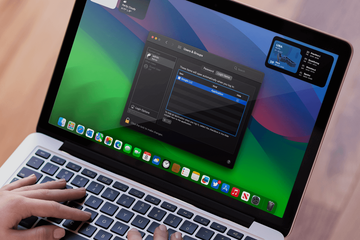- What is the Google LLC background item on Mac?
- Google LLC in the Mac’s Login Items – not really an informed decision
- Security considerations added to the mix
- Should you be worried?
- Google LLC background item manual removal for Mac
- Get rid of Google LLC background item in web browser on Mac
- Get rid of Google LLC background item using Combo Cleaner removal tool
Learn how the Google LLC process ends up on a Mac’s background items list, what it does, how to handle it, and whether it poses security or privacy risks.
What is the Google LLC background item on Mac?
Here’s a quick tip for those who are in the mood of partaking in a hot debate on a random web forum: raise the rhetoric of major internet corporations harvesting user data on a huge scale. The opinions will range from something like “if a product is free, you are the product” – to “these services are outright dangerous”. No matter what the truth is, there’s no denying that tech giants do collect a lot of information about people’s web surfing habits, interests, and even demographic information. At this point, let’s zoom right into the subject matter of this article. An outbreak of privacy-flavored irritation has recently hit the Apple community. It’s caused by the emergence of an object named Google LLC in the Login Items list on laptops and desktops with macOS on board. To many, this has become an awakening discovery that leaves them wondering what this item is, why it ended up among the background processes, and whether or not it’s harmful.
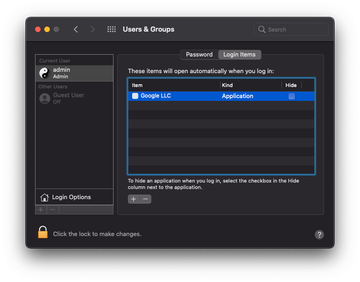
That being said, let’s try to dot the i’s and cross the t’s regarding this story. The Google LLC background item appears to be associated with the services of the eponymous company. When added to the above-mentioned list in the System Preferences app (System Settings in macOS 13 Ventura and up), it gets several privileges. These include the ability to perform tasks like managing updates or synchronizing data when the parental program isn’t open. This is okay as long as the processes involved are benign, which seems to be the case here. The entity under scrutiny often runs alongside Google Updater, which is a known item related to the immensely popular – and undoubtedly harmless – Chrome browser. However, the very manner in which the change happens is reminiscent of obtrusive tactics.
Google LLC background item may re-infect your Mac multiple times unless you delete all of its fragments, including hidden ones. Therefore, it is recommended to download Combo Cleaner and scan your system for these stubborn files. This way, you may reduce the cleanup time from hours to minutes.
Download Now Learn how Combo Cleaner works. If the utility spots malicious code, you will need to buy a license to get rid of it.Google LLC in the Mac’s Login Items – not really an informed decision
According to reports of the users who accidentally found the Google LLC background item on their Macs, they don’t remember getting any dialogs that asked for permission to add it. Sounds like foul play, except that such controversial tactics are fairly common in today’s digital interactions. It could be that a recent update of Chrome, Google Drive, Google Docs, Gmail, or another solution under the same umbrella arrived with a respective tweak in the terms of service. Let’s face it: no one really reads the fine print, and so chances are that people ignore and recklessly click through those technicalities, only to end up granting the access they are now complaining about. Another possibility – albeit less likely – is that the culprit service has somehow bypassed the permission stage.
While it’s super-easy to remove an arbitrary Login Item on a Mac machine with several clicks of a mouse, the pitfall with the Google LLC entity is that the users are instructed to enter their admin password to complete the procedure. Let me dispel some of the conspiracy theories around this: the Users & Groups interface in macOS 12 Monterey and earlier requires you to click the padlock icon and enter your password to make changes to the startup programs. This, however, appears to have changed in newer editions of the operating system. Therefore, if a password request is popping up on your computer running Ventura or Sonoma, that might be fishy.
Security considerations added to the mix
With that in mind, it comes as no surprise that the issue has additionally assumed shades of malicious activity. This sounds far-fetched, but some malware strains, including the rare polymorphic ones, can indeed masquerade themselves as trusted applications. This strategy aims to help dodgy code slip below the radars of traditional security systems. If you are curious, you can run a trivial experiment: pick a program in your Applications list, right click it, and select the Rename option. Type “Google LLC”, and voila, you can now add it to the Login Items under that name and even make the knockoff app appear in the “Allow in the Background” section with the toggle set to “Enable”. In this case, the only giveaway is the icon of the original application next to the item, but experienced cybercriminals can tackle that obstacle so that the copycat looks legit.
Should you be worried?
The big question is whether the Google LLC background item is a virus. My answer is, probably not. It’s a byproduct of a reputable software maker’s update and sync practices. The fact that it launches at boot time and runs behind the scenes without the user’s clear consent appears to be questionably ethical, but it’s very unlikely malicious. If the involvement of this entity in the startup routine is keeping you on your toes regardless, it’s absolutely safe to click that minus sign and remove it from the list, even if you have to enter your password to do it. But to err on the side of caution, consider checking your Mac for potential threats that could mimic or otherwise exploit the trusted service. The following tutorial will lend a hand.
Google LLC background item manual removal for Mac
The steps listed below will walk you through the removal of this malicious application. Be sure to follow the instructions in the specified order.
Expand the Go menu in your Mac’s Finder bar and select Utilities as shown below.
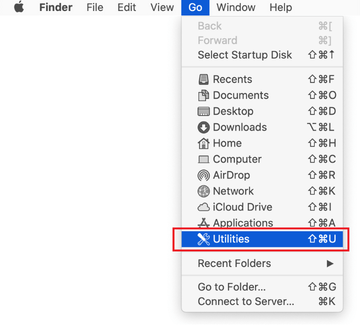
Locate the Activity Monitor icon on the Utilities screen and double-click on it.
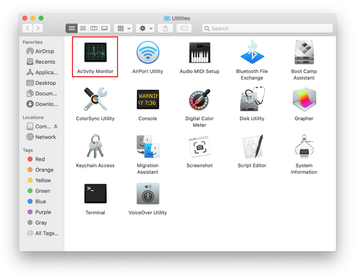
In the Activity Monitor app, look for a process that appears suspicious. To narrow down your search, focus on unfamiliar resource-intensive entries on the list. Keep in mind that its name isn’t necessarily related to the way the threat is manifesting itself, so you’ll need to trust your own judgement. If you pinpoint the culprit, select it and click on the Stop icon in the upper left-hand corner of the screen.
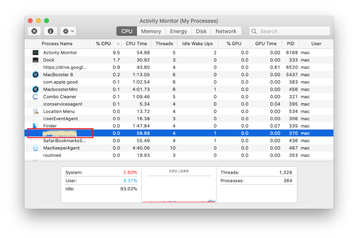
When a follow-up dialog pops up asking if you are sure you want to quit the troublemaking process, select the Force Quit option.
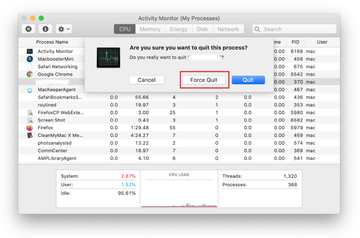
Click on the Go menu icon in the Finder again and select Go to Folder. You can as well use the Command-Shift-G keyboard shortcut.
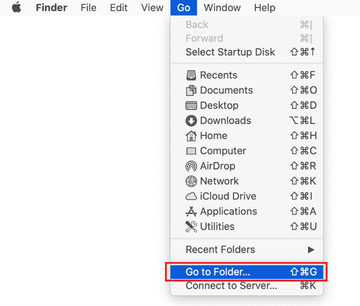
Type /Library/LaunchAgents in the folder search dialog and click on the Go button.
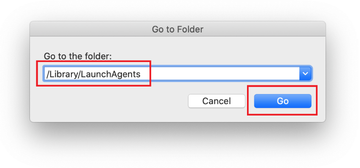
Examine the contents of the LaunchAgents folder for dubious-looking items. Be advised that the names of files spawned by malware may give no clear clues that they are malicious, so you should look for recently added entities that appear to deviate from the norm.
As an illustration, here are several examples of LaunchAgents related to mainstream Mac infections: com.google.GoogleUpdater.wake.plist, com.avickUpd.plist, and com.msp.agent.plist. If you spot files that don’t belong on the list, go ahead and drag them to the Trash.
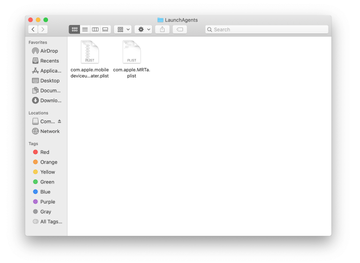
Use the Go to Folder lookup feature again to navigate to the folder named ~/Library/Application Support (note the tilde symbol prepended to the path).

When the Application Support directory is opened, identify recently generated suspicious folders in it and send them to the Trash. A quick tip is to look for items whose names have nothing to do with Apple products or apps you knowingly installed. A few examples of known-malicious folder names are com.AuraSearchDaemon, ProgressSite, and IdeaShared.
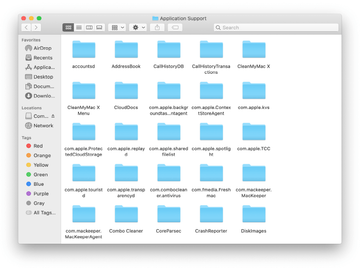
Enter ~/Library/LaunchAgents string (don’t forget to include the tilde character) in the Go to Folder search area.
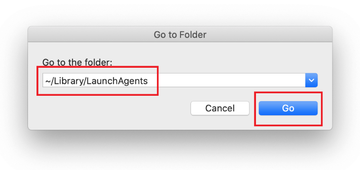
The system will display LaunchAgents residing in the current user’s Home directory. Look for the following dodgy items related to Google LLC background item: com.google.GoogleUpdater.wake.plist, com.ConnectionCache.service.plist, com.digitalprotection.emcupdater.plist, com.mulkey.plist, com.nbp.plist, and com.sys.system.plist. Drag these files to the Trash.
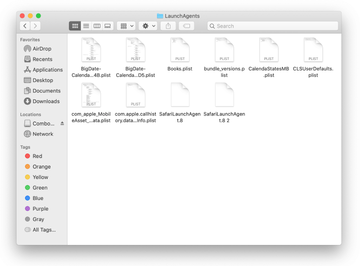
Type /Library/LaunchDaemons in the Go to Folder search field.
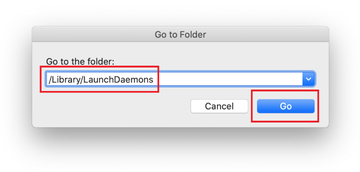
In the LaunchDaemons path, try to pinpoint the files the malware is using for persistence. Several examples of such items cropped by Mac infections are com.google.GoogleUpdater.wake.plist, com.ConnectionCache.system.plist and com.mulkeyd.plist. Delete the sketchy files immediately.
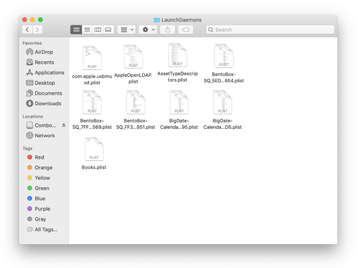
Click on the Go menu icon in your Mac’s Finder and select Applications on the list.
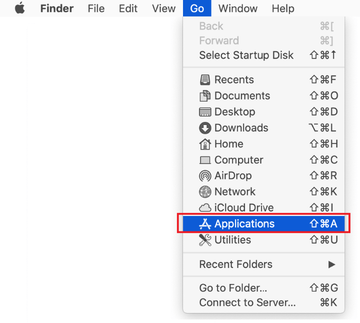
Find the app that clearly doesn’t belong there and move it to the Trash. If this action requires your admin password for confirmation, go ahead and enter it.

Expand the Apple menu and select System Preferences.
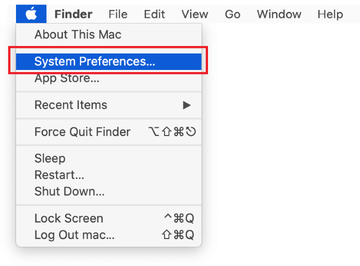
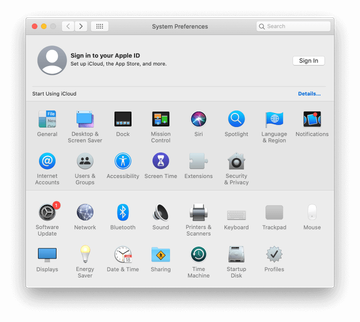
Proceed to Users & Groups and click on the Login Items tab.
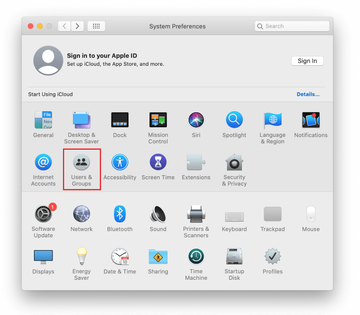
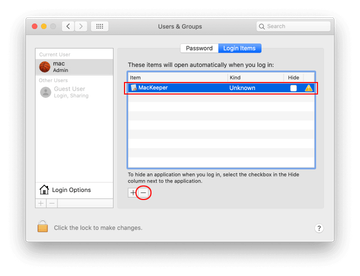
Now select Profiles under System Preferences. Look for a malicious item in the left-hand sidebar. Several examples of configuration profiles created by Mac adware include AdminPrefs, TechSignalSearch, MainSearchPlatform, and Safari Preferences. Select the offending entity and click on the minus sign at the bottom to eliminate it.
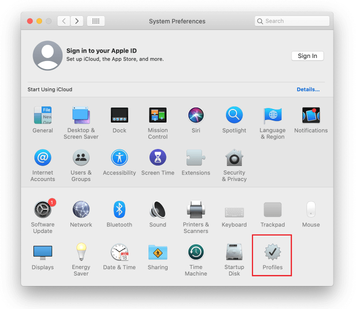
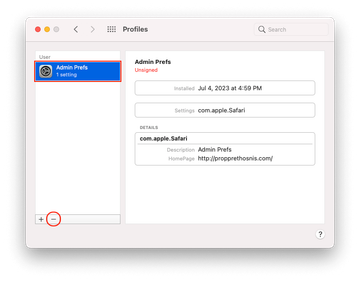
Get rid of Google LLC background item in web browser on Mac
To begin with, the web browser settings taken over by the Google LLC background item malware should be restored to their default values. Although this will clear most of your customizations, web surfing history, and all temporary data stored by websites, the malicious interference should be terminated likewise. The overview of the steps for completing this procedure is as follows:
- Remove Google LLC background item on Safari
- Open the browser and go to Safari menu. Select Preferences in the drop-down list.
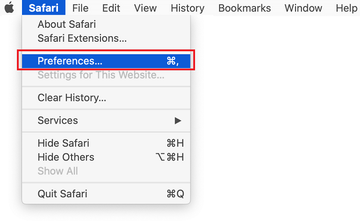
- Once the Preferences screen appears, click on the Advanced tab and enable the option saying “Show Develop menu in menu bar”.
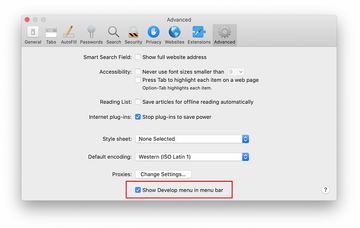
- Now that the Develop entry has been added to the Safari menu, expand it and click on Empty Caches.
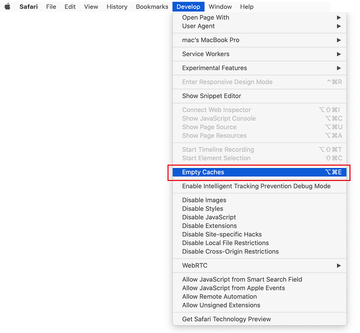
- Now select History in the Safari menu and click on Clear History in the drop-down list.
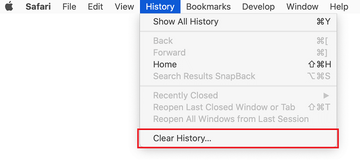
- Safari will display a dialog asking you to specify the period of time this action will apply to. Select all history to ensure a maximum effect. Click on the Clear History button to confirm and exit.

- Go back to the Safari Preferences and hit the Privacy tab at the top. Find the option that says Manage Website Data and click on it.

- The browser will display a follow-up screen listing the websites that have stored data about your Internet activities. This dialog additionally includes a brief description of what the removal does: you may be logged out of some services and encounter other changes of website behavior after the procedure. If you’re okay with that, go ahead and click on the Remove All button.
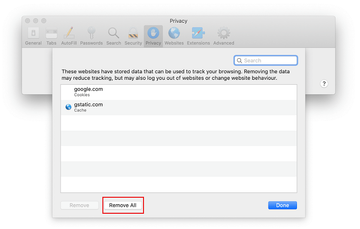
- Restart Safari
- Open the browser and go to Safari menu. Select Preferences in the drop-down list.
- Remove Google LLC background item on Google Chrome
- Open Chrome, click the Customize and control Google Chrome (⁝) icon in the top right-hand part of the window, and select Settings in the drop-down
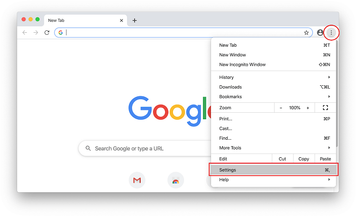
- When on the Settings pane, select Advanced
- Scroll down to the Reset settings section.
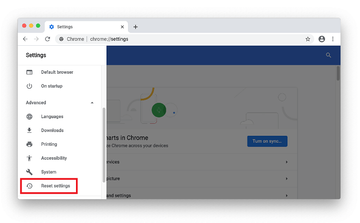
- Confirm the Chrome reset on a dialog that will pop up. When the procedure is completed, relaunch the browser and check it for malware activity.
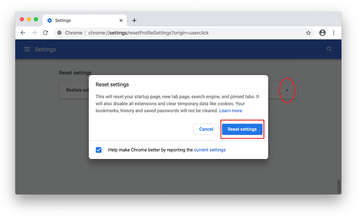
- Open Chrome, click the Customize and control Google Chrome (⁝) icon in the top right-hand part of the window, and select Settings in the drop-down
- Get rid of Google LLC background item on Mozilla Firefox
- Open Firefox and go to Help – Troubleshooting Information (or type about:support in the URL bar and press Enter).
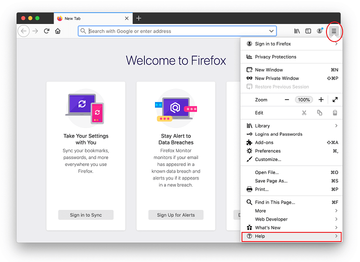
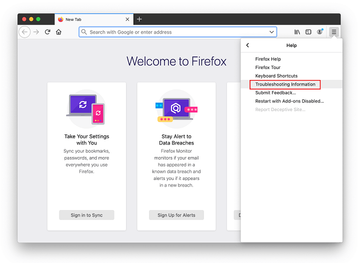
- When on the Troubleshooting Information screen, click on the Refresh Firefox button.
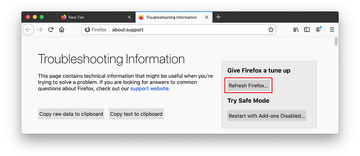
- Confirm the intended changes and restart Firefox.
- Open Firefox and go to Help – Troubleshooting Information (or type about:support in the URL bar and press Enter).
Get rid of Google LLC background item using Combo Cleaner removal tool
The Mac maintenance and security app called Combo Cleaner is a one-stop tool to detect and remove Google LLC background item virus. This technique has substantial benefits over manual cleanup, because the utility gets hourly virus definition updates and can accurately spot even the newest Mac infections.
Furthermore, the automatic solution will find the core files of the malware deep down the system structure, which might otherwise be a challenge to locate. Here’s a walkthrough to sort out the Google LLC background item issue using Combo Cleaner:
Download Combo Cleaner installer. When done, double-click the combocleaner.dmg file and follow the prompts to install the tool onto your Mac.
By downloading any applications recommended on this website you agree to our Terms and Conditions and Privacy Policy. The free scanner checks whether your Mac is infected. To get rid of malware, you need to purchase the Premium version of Combo Cleaner.
Open the app from your Launchpad and let it run an update of the malware signature database to make sure it can identify the latest threats.
Click the Start Combo Scan button to check your Mac for malicious activity as well as performance issues.
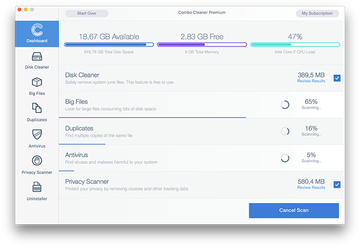
Examine the scan results. If the report says “No Threats”, then you are on the right track with the manual cleaning and can safely proceed to tidy up the web browser that may continue to act up due to the after-effects of the malware attack (see instructions above).
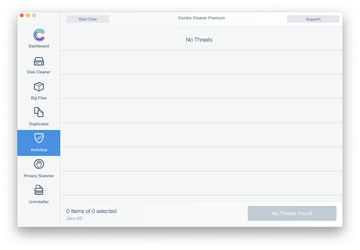
In case Combo Cleaner has detected malicious code, click the Remove Selected Items button and have the utility remove Google LLC background item threat along with any other viruses, PUPs (potentially unwanted programs), or junk files that don’t belong on your Mac.
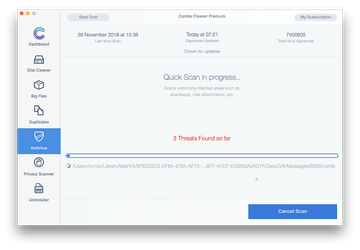
Once you have made doubly sure that the malicious app is uninstalled, the browser-level troubleshooting might still be on your to-do list. If your preferred browser is affected, resort to the previous section of this tutorial to revert to hassle-free web surfing.
